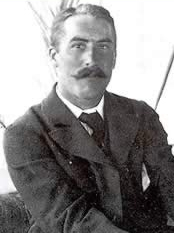|
 Baptism and Birth Records in the UK Baptism and Birth Records in the UK
Case Study: Howard Carter
 Howard Carter (1874–1939) was an English archaeologist and Egyptologist born in Kensington, England. He is most famous as the discoverer of KV62, the tomb of Tutankhamun in the Valley of the Kings, Luxor, Egypt. Howard Carter (1874–1939) was an English archaeologist and Egyptologist born in Kensington, England. He is most famous as the discoverer of KV62, the tomb of Tutankhamun in the Valley of the Kings, Luxor, Egypt.
In 1890, at the age of 16, Carter began copying inscriptions and paintings in Egypt. He worked on the excavation of Beni Hasan, the gravesite of the princes of Middle Egypt, 2000 BC. He is also famous for finding the remains of Queen Hatshepsut's tomb in Deir el-Bahri. In 1899, Carter was offered a position working for the Egyptian Antiquities Service, EAS from which he resigned as a result of a dispute between Egyptian site guards and a group of drunk French tourists in 1905.
After several hard years, Carter was introduced, in 1907, to Lord Carnarvon, an eager amateur who was prepared to supply the funds necessary for Carter's work to continue. Soon, Carter was supervising all of Lord Carnarvon's excavations. Lord Carnarvon financed Carter's search for the tomb of a previously unknown Pharaoh, Tutankhamun, whose existence Carter had discovered. After a few months of fruitless searching, Carnarvon was becoming dissatisfied with the lack of return from his investment and, in 1922, he gave Carter one more season of funding to find the tomb.
On 4 November 1922, after 15 years of searching and being funded, Carter found the steps leading to Tutankhamen's tomb (subsequently designated KV62), by far the best preserved and most intact pharaonic tomb ever found in the Valley of the Kings. He wired Lord Carnarvon to come, and on 26 November 1922, with Lord Carnarvon, Carnarvon's daughter, and others in attendance, Carter made the famous "tiny breach in the top left hand corner" of the doorway, and was able to peer in by the light of a candle and see that many of the gold and ebony treasures were still in place. He did not yet know at that point whether it was "a tomb or merely a cache", but he did see a promising sealed doorway between two sentinel statues.
The next several weeks were spent carefully cataloguing the contents of the antechamber. On February 16, 1923, Carter opened the sealed doorway, and found that it did indeed lead to a burial chamber, and he got his first glimpse of the sarcophagus of Tutankhamun.
The extensive finds, Carter retired from archaeology and became a collector. He visited the United States in 1924, and gave a series of illustrated lectures in New York City which were attended by very large and enthusiastic audiences. He died in England on March 2, 1939 at the age of 64.
Finding Howard Carter's Birth Record
I started my search by logging into TheGenealogist, and choosing the search BMD Indexes. Selecting 'Birth Records' in 'Image Search', I typed in 'Howard Carter' into the name box and chose the year of birth as 1874.
 Knowing he was born in May in Kensington meant that I could easily find his record - I chose to view the image for Apr-Jun, and found him near the end of the page (see image to the right). Knowing he was born in May in Kensington meant that I could easily find his record - I chose to view the image for Apr-Jun, and found him near the end of the page (see image to the right).
For more case studies, visit UKMarriages.org and UKBurials.net.
|
|